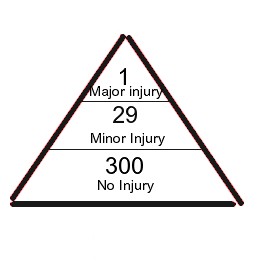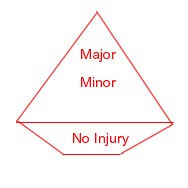My Interests/MGMT
Heinrich's Law
shonini
2014. 6. 15. 16:35
The Heinrich Law
Statistics can tell us if our accident and incident reporting is working
Herbert William Heinrich (born 1886) was an American industrial safety pioneer from the 1930s. He was an Assistant Superintendent of the Engineering and Inspection Division of Travelers Insurance Company when he published his book Industrial Accident Prevention, A Scientific Approach in 1931.
One empirical finding from his 1931 book became known as Heinrich's Law: that in a workplace, for every accident that causes a major injury, there are 29 accidents that cause minor injuries and 300 accidents that cause no injuries. Because many accidents share common root causes, addressing more commonplace accidents that cause no injuries can prevent accidents that cause injuries.
One empirical finding from his 1931 book became known as Heinrich's Law: that in a workplace, for every accident that causes a major injury, there are 29 accidents that cause minor injuries and 300 accidents that cause no injuries. Because many accidents share common root causes, addressing more commonplace accidents that cause no injuries can prevent accidents that cause injuries.
This ratio can be shown graphically as a pyramid

No Injury
Other writers have added the fourth dimension - hazards identified before they have caused an incident.
The Bird Study
The Bird Study
In 1969, a study of industrial accidents was undertaken by Frank E. Bird, Jr., who was then the Director of Engineering Services for the Insurance Company of North America.
Bird analysed 1,753,498 accidents reported by 297 cooperating companies. These companies represented 21 different industrial groups, employing 1,750,000 employees who worked over 3 billion hours during the exposure period analyzed. The study revealed the following ratios in the accidents reported: For every 1 reported major injury (resulting in fatality, disability, lost time or medical treatment), there were 9.8 reported minor injuries (requiring only first aid). For the 95 companies that further analyzed major injuries in their reporting, the ratio was one lost time injury per 15 medical treatment injuries.
It is critical that accident investigation be entered into knowing that we can make a difference if we can find the true causes of the accident. This means dropping any assumptions that there is nothing that can be done - "it is an accident".
Bird analysed 1,753,498 accidents reported by 297 cooperating companies. These companies represented 21 different industrial groups, employing 1,750,000 employees who worked over 3 billion hours during the exposure period analyzed. The study revealed the following ratios in the accidents reported: For every 1 reported major injury (resulting in fatality, disability, lost time or medical treatment), there were 9.8 reported minor injuries (requiring only first aid). For the 95 companies that further analyzed major injuries in their reporting, the ratio was one lost time injury per 15 medical treatment injuries.
It is critical that accident investigation be entered into knowing that we can make a difference if we can find the true causes of the accident. This means dropping any assumptions that there is nothing that can be done - "it is an accident".
If we review the company statistics and find that for ever major injury we have multiple minor injuries, which is to be expected, but for ever minor injury, we are reporting fewer 'no-injury' events, we can deduce that our reporting system is not working.

Having dropped that assumption of "an accident", we should realise that we should investigate all accidents and "near miss" incidents as well as reported hazards.
http://www.myblogsite.com.au/The-Heinrich-Law.html